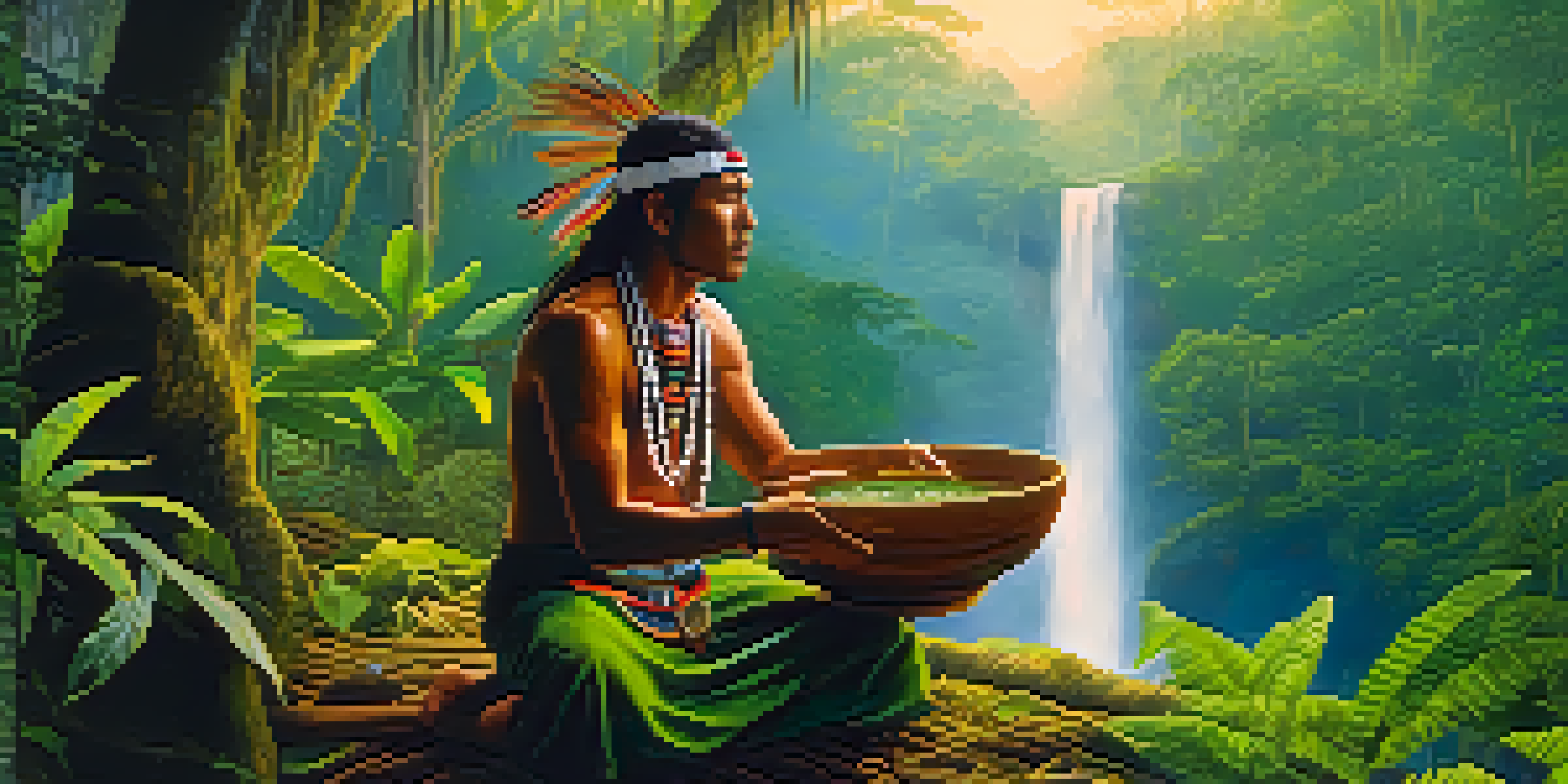The Science Behind Ayahuasca: Bridging Tradition and Modernity

What is Ayahuasca and Its Historical Roots?
Ayahuasca is a traditional Amazonian brew made from the Banisteriopsis caapi vine and the Psychotria viridis leaf. For centuries, indigenous tribes have used it in spiritual ceremonies, believing it opens pathways to the spirit world. This rich history showcases a deep connection between nature and human consciousness.
Ayahuasca is an extraordinary teacher. It teaches not only about the self, but also about the interconnectedness of all beings.
The use of ayahuasca is often linked to shamanism, where shamans serve as guides for those seeking healing or insight. These rituals not only foster a sense of community but also serve as a gateway to understanding one's place in the universe. As more people become aware of its potential, ayahuasca's traditional roots are gaining global recognition.
Today, ayahuasca retreats have emerged worldwide, offering seekers a chance to experience its transformative effects. This blend of ancient wisdom and modern exploration invites a deeper examination of its implications for mental health and spirituality.
The Active Compounds in Ayahuasca Explained
The primary active ingredients in ayahuasca are DMT (dimethyltryptamine) and MAO inhibitors found in the caapi vine. DMT is a powerful psychedelic that can induce deep introspective experiences, while the MAO inhibitors allow DMT to be orally active. This unique combination creates a profound effect that is both spiritual and therapeutic.

Understanding how these compounds interact within the body is crucial. When ingested, the MAO inhibitors prevent the breakdown of DMT, leading to an extended experience that can last several hours. This chemical dance not only alters perception but also opens the mind to new ways of thinking and feeling.
Ayahuasca's Cultural Roots
Ayahuasca has deep historical and cultural significance for indigenous tribes, serving as a vital part of their spiritual practices.
Research into these compounds has revealed their potential benefits, particularly in treating conditions like depression and PTSD. By demystifying the science behind ayahuasca, we can better appreciate its role in both traditional practices and modern therapeutic contexts.
Ayahuasca and Mental Health: A Growing Interest
In recent years, ayahuasca has attracted attention from the mental health community for its potential therapeutic effects. Studies suggest that the brew can lead to significant improvements in mood, emotional regulation, and overall mental well-being. This has sparked a movement to explore alternative treatments for mental health issues beyond conventional pharmaceuticals.
The experience of ayahuasca is an invitation to explore the depths of our consciousness and engage with the mysteries of existence.
Participants in ayahuasca ceremonies often report transformative experiences, including a sense of catharsis and heightened self-awareness. These outcomes are believed to stem from the brew's ability to facilitate deep emotional exploration and healing. By addressing trauma and unresolved emotional issues, ayahuasca may offer a new path for recovery.
However, while the anecdotal evidence is compelling, more rigorous scientific studies are needed to fully understand its efficacy and safety. This intersection of traditional healing and modern scientific inquiry opens exciting avenues for future research.
Cultural Significance of Ayahuasca in Indigenous Communities
For indigenous communities in the Amazon, ayahuasca is much more than a psychedelic experience; it’s a vital part of their cultural identity. The brew is woven into the fabric of their spiritual practices, serving as a bridge between the physical world and the spiritual realm. This cultural significance underscores the importance of respecting traditional knowledge as we explore ayahuasca's modern applications.
Ayahuasca ceremonies often involve rituals that connect participants with nature, ancestors, and the cosmos. These experiences foster a sense of belonging and purpose, highlighting the communal aspect of healing. As people from diverse backgrounds participate in these rituals, it’s essential to honor and preserve the traditions of the indigenous cultures that have safeguarded this knowledge for centuries.
Therapeutic Potential Explored
Recent studies indicate that ayahuasca may offer therapeutic benefits for mental health, particularly in treating depression and PTSD.
The growing popularity of ayahuasca raises questions about cultural appropriation and the commodification of spiritual practices. Striking a balance between sharing this profound experience and respecting its origins can help ensure that indigenous communities benefit from the global interest in ayahuasca.
Scientific Research: Studies on Ayahuasca's Effects
Recent research has begun to shed light on the effects of ayahuasca, with studies exploring its impact on mental health, consciousness, and neurobiology. Findings have indicated that ayahuasca can lead to lasting positive changes in mood and outlook, particularly for those suffering from depression and anxiety. This scientific validation of traditional use is a promising development in the field of psychedelic research.
Studies have also investigated the neurobiological mechanisms underlying ayahuasca's effects. For instance, research has shown that ayahuasca may promote neuroplasticity, the brain's ability to reorganize itself by forming new neural connections. This could explain how such experiences can lead to profound personal insights and emotional healing.
As interest in psychedelics grows, it’s crucial to approach research with rigor and caution. By employing scientific methods to study ayahuasca, we pave the way for its potential integration into therapeutic practices while ensuring the safety and well-being of participants.
Potential Risks and Ethical Considerations
Despite the growing interest in ayahuasca, it’s essential to acknowledge the potential risks associated with its use. Some individuals may experience adverse psychological effects, particularly if they have a history of mental health issues. It’s crucial for participants to be well-informed and prepared for the intensity of the experience.
Additionally, the setting in which ayahuasca is consumed plays a significant role in determining the outcome. A supportive environment, guided by experienced practitioners, can enhance safety and efficacy. Conversely, an improper setting can lead to challenging experiences that may overwhelm participants.
Ethical Considerations in Use
As ayahuasca gains popularity, it's crucial to address the ethical implications and potential risks associated with its use, especially in tourism.
Ethical considerations also arise in the context of ayahuasca tourism, where individuals travel to indigenous areas for retreats. It’s vital for these experiences to be respectful and mutually beneficial, ensuring that local communities are supported and their traditions honored.
The Future of Ayahuasca: Integrating Tradition with Innovation
As we move forward, the future of ayahuasca lies in the integration of traditional practices with modern scientific understanding. This fusion can lead to innovative therapeutic approaches that honor both the wisdom of indigenous cultures and the insights of contemporary research. By fostering collaboration between these two worlds, we can create a more holistic understanding of ayahuasca's potential.
Incorporating ayahuasca into formal therapeutic settings could offer new pathways for healing and personal growth. Research is already underway to explore how structured ayahuasca experiences can be safely implemented in clinical environments. This approach could bridge the gap between ancient healing traditions and modern mental health care.

Ultimately, the journey of ayahuasca is about more than just the substance itself; it’s about the connections we forge with ourselves, others, and the world around us. As we navigate this evolving landscape, maintaining a balance between respect for tradition and the pursuit of scientific knowledge will be key to unlocking the full potential of ayahuasca.